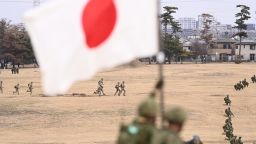A Japanese warship is set to enhance its military capabilities by integrating Tomahawk cruise missiles, which can strike targets up to 1,000 miles away. The JS Chokai, an Aegis-equipped guided-missile destroyer, is currently en route to the United States for a year-long deployment. During this time, the ship will undergo modifications and crew training aimed at enabling it to launch these advanced missiles, strengthening Japan’s defense posture amid growing regional tensions.
Japan signed a deal with the United States in early 2024 to acquire 400 Tomahawk missiles as part of its initiative to bolster defense spending. The Japanese Defense Minister, Gen Nakatani, described the current security landscape as the “most severe and complex security environment” since World War II. The annual defense white paper published in July identified China’s military activities as “the greatest strategic challenge” to Japan’s security, citing Beijing’s rapid military advancements and increased assertiveness in the region.
China has expressed strong opposition to Japan’s military enhancements. The Chinese Foreign Ministry’s spokesperson, Mao Ning, criticized the collaboration between the United States and Japan, claiming it escalates the arms race and disrupts global stability. The tensions are particularly pronounced around the Senkaku Islands, a chain in the East China Sea claimed by both Tokyo and Beijing.
Military Enhancements and Regional Implications
The JS Chokai is scheduled to be equipped for “actual missions” by next summer, with live-fire testing planned. Recent practice drills have included loading dummy Tomahawk munitions into the destroyer’s vertical launch cells. The 528-foot-long vessel, displacing 9,500 tons, is equipped with 90 vertical launch cells capable of launching a variety of missiles, including surface-to-air and anti-ballistic missiles. The ship’s capabilities are comparable to those of the US Navy’s Arleigh Burke-class destroyers.
The Tomahawk cruise missile is one of the most reliable weapons in the US arsenal, noted for its precision strikes even in heavily defended airspace. Manufacturer Raytheon reports that these missiles have been deployed in combat over 2,000 times, including recent actions targeting Iranian nuclear facilities. The Tomahawk’s designation as a “Land Attack Missile” underscores its offensive capabilities, despite Japan framing its acquisition as a defensive measure.
Australia has joined the ranks of countries demonstrating Tomahawk launch capabilities, successfully firing a missile from the destroyer HMAS Brisbane in December 2022. The Australian Defense Ministry has indicated plans to acquire 200 Tomahawk missiles, enhancing its naval forces’ long-range strike capabilities.
The rising military capabilities of both China and North Korea, alongside Japan’s enhancements, illustrate an intensifying arms race in the Pacific region. Military parades in Beijing have showcased China’s advancements, including the display of powerful anti-ship missiles. The presence of North Korean leader Kim Jong Un alongside Chinese President Xi Jinping during recent military events highlights the growing alliance among these nations.
As Japan fortifies its military capabilities, the implications for regional security dynamics continue to evolve. The commitment to long-range missile systems indicates a shift in Japan’s defense strategy, reflecting the broader trends in military modernization among Pacific nations.
